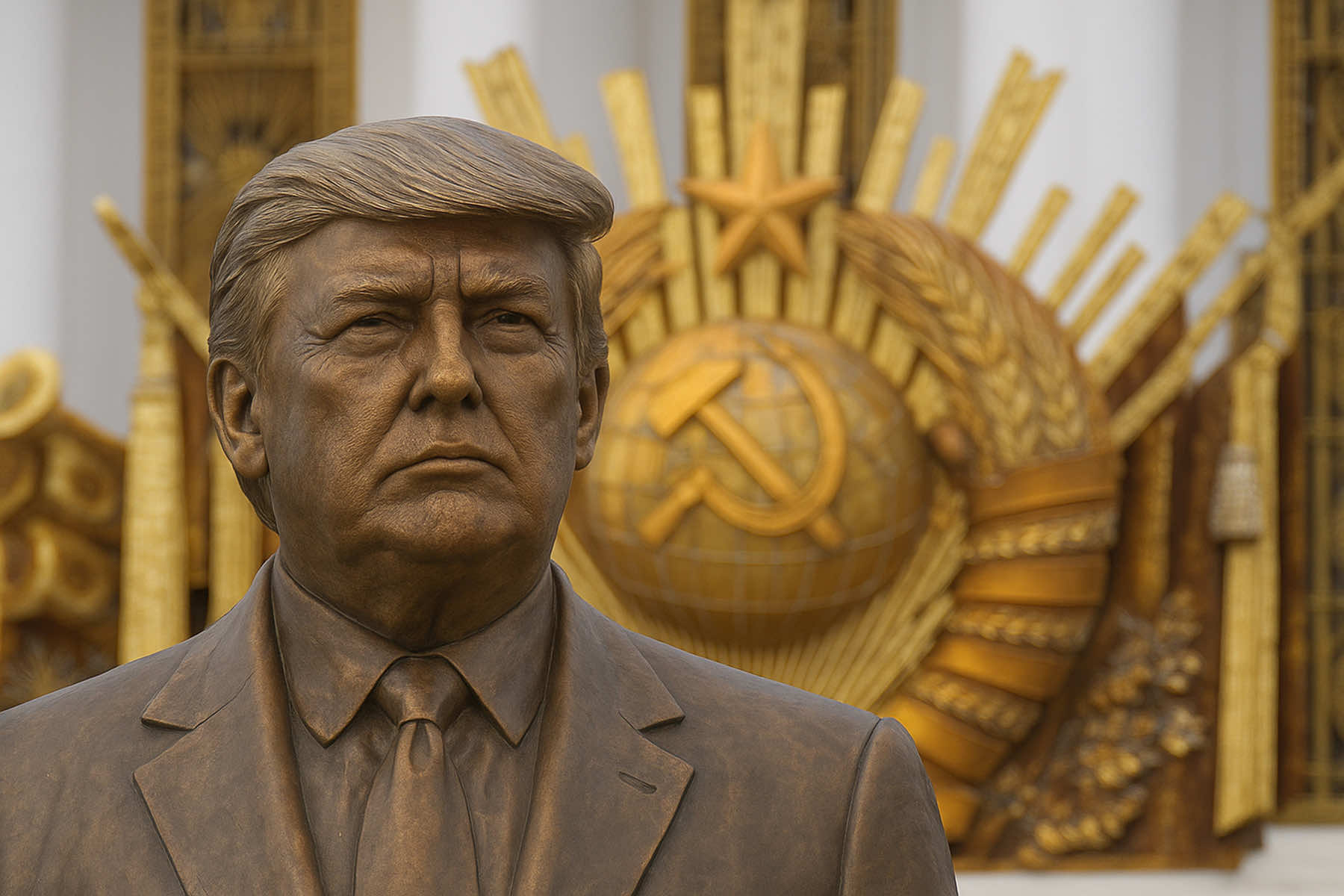
In the debate over the direction of the United States under Donald Trump’s second term in the White House, familiar political labels have returned with renewed force. Accusations of socialism and communism have been leveled across ideological lines, most often as rhetorical attacks against progressive Democrats.
But a closer examination of recent federal economic activity raises a provocative question: are the mechanisms of government under Trump aligning more closely with the textbook definition of a communist state?
At the core of communist economic theory is state ownership or control of the means of production. While the term has historically been used to describe totalitarian regimes operating under Marxist-Leninist ideology, the economic function of such governments centers on centralized control, suppression of private capital, and direct political influence over industrial output.
Trump’s regime, while not ideologically leftist, has enacted a series of state interventions and structural controls that in practical terms resemble the tools used by communist governments to direct and absorb national economic activity.
One of the most striking developments came in July 2025, when the Department of Defense acquired a controlling stake in MP Materials, a Nevada-based rare earth mining company. This move was justified on the basis of national security and domestic supply chain stability, but the outcome was a form of nationalization.
By becoming the majority shareholder, the federal government now holds direct influence over a critical sector of resource extraction, a foundational aspect of economic sovereignty. While this was not the first time the Defense Production Act was used to shape private industry, the scale and permanence of this ownership marked a significant expansion of federal reach.
Parallel to these actions, the regime has also consolidated control over independent agencies once considered outside direct executive influence. Through a combination of executive orders and personnel reshuffling, entities such as the Federal Communications Commission, Securities and Exchange Commission, and Consumer Financial Protection Bureau have been brought under the centralized authority of the White House.
This structural realignment positions the executive branch to exert strategic pressure across financial, regulatory, and infrastructural domains without the checks typically afforded by independent oversight.
Moreover, procurement reform under the Trump administration has produced new gatekeeping mechanisms that resemble central planning. The formation of the Department of Government Efficiency (DOGE) in early 2025 created a streamlined apparatus for government contracting and agency budgeting.
Though pitched as a cost-cutting measure, DOGE has effectively centralized all major procurement decisions under a single administrative body with broad discretionary powers. This reorganization grants the executive branch near-total authority to dictate which firms receive contracts, which projects are approved, and which assets are retained or liquidated.
The influence of political alignment on these decisions further underscores the shift. Contractors and firms seen as favorable to the administration’s policies have benefited from exclusive government deals, while companies critical of the administration have faced barriers to entry.
The $200 million contract awarded to a politically allied artificial intelligence firm drew criticism not only for its size, but for the administration’s clear preference for vendors who agreed to model content in line with federal “neutrality” standards, a policy that critics argue enforces ideological compliance as a condition of participation in the national economy.
In another significant move, the administration has revived and expanded its efforts to force the divestment of foreign-owned assets deemed politically undesirable. The reactivation of the push to sever ByteDance’s ownership of TikTok has led to renewed pressure on foreign investors to cede control to U.S.-based firms selected by the administration.
Though framed as a national security imperative, the use of federal power to compel the sale and restructure of a private entity aligns with the kind of state-controlled industrial management more commonly associated with non-market economies.
Supporters of these efforts argue that such measures are necessary responses to geopolitical threats and economic vulnerabilities. However, the cumulative effect of state acquisitions, contract gatekeeping, and agency realignment has reoriented the federal government into a central economic actor, less a referee and more a market participant with decisive control.
This transformation is not symbolic. It involves real capital flows, asset management, and corporate decision-making directed by government hands. Traditional definitions of American capitalism are built on the premise that government should regulate, but not dominate, market behavior.
Yet under the current regime, that boundary has been redefined. The federal government has moved beyond regulating private companies to actively shaping their structure, leadership, and access to capital. In some cases, firms are being compelled to alter ownership structures to continue operating domestically. In others, lucrative contracts are awarded based on political compatibility, bypassing open competition.
This approach mirrors the practical framework of communist economic systems, where state direction of production replaces market determination. The key distinction lies not in rhetoric or ideology, but in execution. When the government chooses which companies operate, which survive, and which collapse — not through market forces, but through administrative power — the result is a state-managed economy regardless of the political label applied.
This structural consolidation has not gone unnoticed by foreign observers and economic analysts, who increasingly compare the United States’ current trajectory with that of centralized economies it once opposed.
The difference is that instead of a formal ideology driving nationalization, the current model is driven by executive discretion, framed as pragmatism, and selectively enforced. The result is a hybrid system — art crony capitalism, part administrative socialism — where access to capital and market participation are shaped less by innovation or competitiveness and more by compliance with centralized mandates.
Beyond rare earth mining, additional sectors have shown signs of shifting toward implicit state guidance. Several domestic technology firms have reported informal pressure to align their operations with administration priorities, particularly on issues of content moderation, data localization, and platform policy.
While no explicit ownership transfers have occurred in these cases, the repeated threat of regulation, divestment orders, or license revocation has produced a chilling effect akin to direct control. In effect, private corporations operate under a system of conditional autonomy, permitted to function, but only within parameters set by the executive branch.
Meanwhile, infrastructure planning has taken on a similarly top-down shape. Large-scale transportation, broadband, and defense logistics projects are now often awarded through fast-tracked processes controlled by politically appointed procurement boards.
These boards are housed within reorganized executive agencies and are empowered to bypass traditional competitive bidding. While defenders of the model claim it increases efficiency, critics argue that it undermines market fairness, favors insiders, and invites long-term economic distortion.
Perhaps most emblematic of the shift is the government’s increasing tendency to dictate the terms of corporate ownership through backdoor mechanisms. Regulatory leverage, tax penalties, access to federal facilities, and approval of mergers are being used in concert to push firms toward desired outcomes without formal legislation. This quiet form of economic coercion allows the administration to deny it is nationalizing anything, while still achieving state, driven objectives across key industries.
Taken together, these developments challenge the narrative that communism is purely a matter of ideology. They demonstrate that when the state accumulates enough power over who produces, who profits, and who gets access, the resulting system begins to resemble command economies regardless of the political context.
The American flag may fly over these agencies and policies, but the mechanisms increasingly reflect systems long derided as antithetical to free enterprise.
What makes the current shift more difficult to detect is its rhetorical camouflage. Because the administration presents each action as a matter of national interest—whether in the name of defense, efficiency, or fairness—public scrutiny is diluted.
Unlike Cold War-era nationalizations, which were publicly declared and ideologically framed, these are implemented incrementally, often buried in regulatory filings, procurement notices, and contract schedules. The scale of centralization is vast, but its visibility remains low.
Critics who attempt to draw attention to these trends often find themselves met with the same accusations the regime directs at its opponents: being un-American, soft on security, or hostile to growth. The labeling serves to silence inquiry while reinforcing a binary political narrative—one in which only enemies of the state question its economic strategies.
If these trends continue, the long-term consequences may outlast the administration that initiated them. A generation of businesses may grow accustomed to seeking favor instead of competing in open markets. Investors may shift priorities from product innovation to political alignment. Workers may find their job security tied less to performance than to their employer’s relationship with the state.
What emerges is not a doctrinaire communist state, but something functionally similar: an economic system where power flows downward, decisions are centralized, and markets respond not to demand, but to decree.
Whether labeled nationalist, authoritarian, or populist, the structure itself bears a closer resemblance to controlled economies than to the capitalist systems it claims to defend.
In this context, the term “communism” is no longer a purely partisan insult. It becomes a technical description of a system where state power supersedes market autonomy. When the federal government becomes the ultimate arbiter of which companies thrive, what products are made, and who can participate in the economy, the ideological pretense becomes irrelevant.
What remains is control. The irony is that such control now originates from a regime that built its brand on the promise of deregulation, free enterprise, and resistance to government overreach.
Yet through mechanisms of ownership, procurement, pressure, and coercion, it has ushered in a model of economic governance more aligned with centralized planning than market freedom.
© Image
Cora Yalbrin (via ai@milwaukee)














